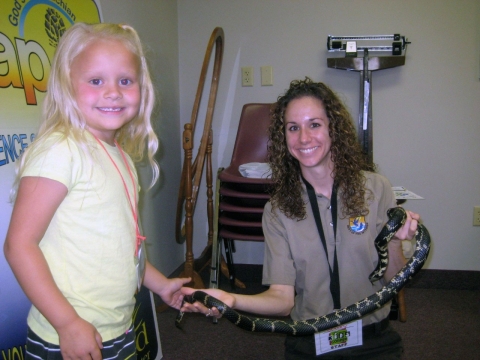The caller had no doubt when Stacey Hayden picked up the phone at Clarks River National Wildlife Refuge.
“I’m not sure if anyone has reported it yet, but I found the chupacabra,” the caller reported. “It’s on the side of the highway, dead.”
A chupacabra, dear reader, is the stuff of legend – a beast that attacks animals and drinks their blood. The first reported sighting of a chupacabra occurred more than 20 years ago in Puerto Rico. Since then, the myth, if not the actual monster, has – excuse the pun – gained legs. Suddenly, it appeared that the rough beast had slouched all the way to Kentucky.
A refuge is no place for a vampiric monster, so staffers checked out the report. And they found…?
Hayden: “It was a fox with mange.”
Today, World Ranger Day, is the sort of holiday for which Hayden could have a speaking role. She’s technically not a ranger – no flat hat for her; they are synonymous with another branch of the federal government – but Hayden does everything a ranger does … and more.
“I like the diversity here,” Hayden said in a rare moment between juggling tasks that range from A (animal identification) to V (working with volunteers) – and, on occasion, Z (zany, as in chupacabra sightings). “I like seeing how it all works.”
Hayden is the kind of worker an administrator wants, said Michael Johnson, who manages Clarks River and Green River National Wildlife Refuges. He hired Hayden to the U.S. Fish and Wildlife Service (Service), and has never regretted that decision.
“She has a great spirit and drive to not only to succeed, but to do it in a way that is motivational and inspirational to others,” he said. “It’s contagious.”
‘Glue’ that binds
She was just a kid when her dad invited her into the woods. Young Stacey bounded behind him into the forests of Paducah, Kentucky. There, amid the hardwoods and pines, a girl got her introduction to the wild world. Her dad taught her to hunt, to track, to learn the ways of the woods.
She became such an outdoors girl that she quit Girl Scouts and joined her dad, a scoutmaster, when he took his Boy Scout troop into the forests. “I stayed in his tent,” she recalled.
That early introduction to the outdoors life led Hayden to the Kentucky refuges. She’s been working with the Service for a decade.
Hayden, 37, was drawn to the Service while attending Murray State University in Kentucky. A wildlife biology major, Hayden decided she needed some hands-on critter experience to augment her classroom lessons. She got a summer job in eastern Illinois “frog-logging,” listening to frog calls and writing down the different species she heard. That experience was enough to get her an internship with the Service. She liked it so much she never left.
Hayden updates Facebook posts and engages in other social media, works with volunteers, arranges field trips to the refuges, visits schools and is usually on hand to answer visitors’ questions.
“Every spring, people ask about baby animals,” she said.
Every year, Hayden coordinates a litter pickup day that brings volunteers to make things clean again. They conclude with a free meal and heartfelt thanks from Hayden. In the fall, Clarks River sets aside a day for families to bring fishing poles and high hopes that they’ll yank a catfish from a refuge pond. Hayden heads that up, too.
Hayden makes volunteers’ jobs easier, said Happy Chambers, president of the Friends of Clarks River National Wildlife Refuge, a nonprofit group dedicated to improving the refuge.
“She’s really the glue that holds us all together,” Chambers said.
No job is too small for Hayden. On July 23, some volunteers met to band birds at the refuge. When they arrived, there was Hayden, waiting with soap. That might not sound like a big deal until you try banding birds without soap.
“I don’t know what we’d do without her,” Chambers said.
You cannot discuss Hayden’s work without learning about Luna Lovegood – no, not the pleasant-but-spacy young witch in the “Harry Potter” series, but instead a screech owl. The bird, whose checker-sized eyes regard the world with a perpetually surprised expression, is one of the creatures she uses to explain refuges’ role in conservation.
“Everyone loves her,” Hayden said.
One of Hayden’s loves: banding birds. She participates in annual songbird bandings at Clarks River. It is a process that calls for patience and a deft touch: some birds have legs no thicker than a kitchen match; when she bands them, Hayden is gentle.
When she’s not reaching out to school kids, updating social media, working with volunteers, banding birds or stalking woodland vampires, Hayden likes to assemble puzzles – the bigger and more difficult, the better. Her office walls features a dozen puzzles that she’s assembled.
“I glue them after I finish,” she said. “I don’t have the heart to take them apart.”
Sometimes, she enlists her husband, Jon, to help her. He’s happy to assist … until the puzzle gets too hard. Then he remembers something else he has to do.
This past winter, Hayden tackled the most difficult puzzle she’s encountered – a 3,000-piece depiction of a path in the woods. “The pieces were all brown,” she said, “and they were so small.” It took her all winter.
Now, with summer busting out everywhere, Hayden is going full-tilt with duties that change from day to day. She’d never heard of World Ranger Day.
“I knew about National Doughnut Day, and wasn’t there an Ice Cream Day not long ago?” she asked. Then Hayden laughed. “I keep track of all the important holidays.”





